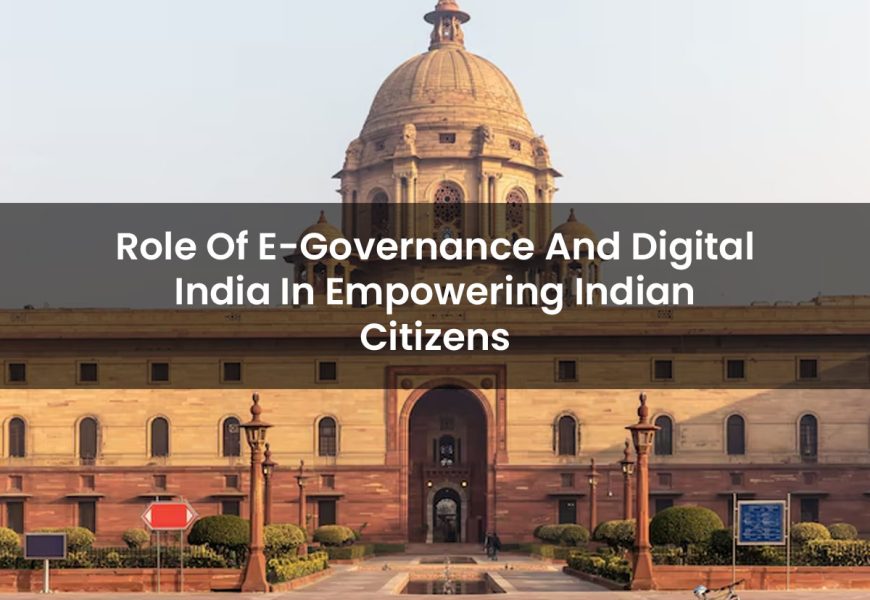E-Governance initiatives have emerged as critical tools for enhancing developmental outcomes. It has seamlessly integrated with the Digital India programme. Technology serves as a key facilitator, delivering citizen-centric E-Governance services efficiently and coherently.
The Digital India programme, spearheaded by the central government, has significantly boosted the adoption of digital technologies across the country. This initiative has brought digital technology to the forefront, making it an integral part of governance and improving the lives of citizens.
In this article, we explore Digital India’s pivotal role in transforming governance and its impact on everyday lives.
What is Digital India?
The Ministry of Electronics and Information Technology (MeitY), Government of India, initiated the ‘Digital India’ program with the vision of propelling India into a digitally empowered society and knowledge-based economy. This entails ensuring digital access, inclusion, empowerment, and bridging the digital gap. The overarching mission is to leverage digital technologies to enhance the lives of every citizen, boost India’s digital economy, foster investment and employment opportunities, and enhance the country’s global digital prowess.
Electronic governance, or E-governance, entails the adept utilisation of information and technology by the government to expedite communication transactions and integrate various standalone systems and services. The vision of the Digital India Programme is to metamorphose India into an empowered society and educated economy.
This is achieved through a focus on three key pillars:
- Digital Infrastructure: Ensuring digital infrastructure is treated as a fundamental utility accessible to every citizen.
- Governance and Services on Demand: Providing governance and services as per the demand of citizens, facili tated by digital platforms.
- Digital Empowerment of Citizens: Empowering citizens through digital literacy and enabling them to leverage digital resources for their advancement.
Why is E-Governance Important?
As technology continues to integrate with government operations, its role in enhancing security and providing integrated services has become increasingly significant. This is particularly true for ensuring seamless data privacy. Since the launch of the Digital India programme in 2015, both central and state governments have made substantial progress in digitising records and infrastructure to benefit every citizen.
A key component of this initiative is E-Governance, which combines advanced technology with skilled personnel to deliver front-end services. For example, on February 10, 2021, Odisha introduced several citizen-centric online services, particularly for the State Transport Department. This digital initiative allows vehicle owners the freedom to choose any transport office in Odisha for services. Odisha is also the first state in India to implement document upload and digital signatures through platform services, alongside launching nine new online services.
These advancements reflect the collaboration between global tech partners, government, and citizens, showcasing a strong reputation in areas such as E-Visa, biometric authentication, and document attestation.
A research report indicates that in the United States, 90% of citizens use websites as their primary means of interacting with the government, with 75% preferring to complete transactions online. E-Governance fosters trust and transparency, with 67% of people more likely to trust the government when they can interact with it online. Furthermore, digitizing government service delivery could help save governments worldwide a cumulative total of $1 trillion annually, according to research.
Greater Convenience
Government services such as issuing birth and death certificates, trade licenses, building permissions, and permits can now be delivered faster and more efficiently online. Traditionally, these processes required citizens or businesses to visit government offices, locate the correct department, stand in long queues, fill out forms, pay fees, and attach photocopied documents. This time-consuming process often had to be repeated if any errors were made.
E-governance revolutionises this experience by moving service delivery online. Citizens can fill out forms, attach scanned documents, make payments, and submit requests from the comfort of their homes. This significantly reduces the time and eliminates the need for travel. Mobile apps further enhance convenience, allowing services to be accessed on the go.
Access to Information
Accurate and timely information empowers citizens to make better decisions, benefiting society as a whole. E-governance enables the dissemination of information through electronic media such as email, SMS, WhatsApp, and social media. For instance, government policies related to COVID-19 restrictions were primarily communicated through these channels, ensuring citizens were informed on how to contribute to controlling the spread of the virus.
Reduced Corruption
E-governance modules facilitate remote interactions between citizens, businesses, and government offices, eliminating the need for intermediaries and reducing opportunities for corruption. This direct interaction ensures that citizens and businesses receive accurate information and services without the need for any undue influence or bribery.
Improved Delivery and Efficiency
Traditional paper-based delivery of government services is inefficient, time-consuming, and error-prone, often hampered by personal biases. E-governance applications streamline these processes by automating them, resulting in faster decision-making and service delivery. This shift from manual to digital processes enhances the scalability and efficiency of service delivery by removing human limitations.
Cost-friendly
E-governance applications reduce the cost of service delivery through economies of scale. The per-application cost in electronic mode is significantly lower compared to traditional methods. E-governance transforms government operations both internally and externally, serving as a tool for public service improvement and governmental change. It redefines how the government conducts business and delivers services, enhancing overall efficiency and effectiveness.
E-Governance Initiatives by the GOI
There have been a range of initiatives taken by the government to take administration online for the citizens. There are three main programs to achieve the goal. Let’s discuss this briefly in the section below:
Digital India Initiative
Launched in 2015, the Digital India Initiative (DII) is a flagship program by the Indian government aimed at transforming India into a digital economy with active participation from citizens and businesses. This initiative aspires to create a digitally empowered society and a knowledge economy enriched with high intellectual capital.
The Digital India initiative aims to achieve the following key visions:
- Digital Infrastructure as a Utility for Every Citizen
- Governance and Services on Demand
- Citizen Digital Empowerment
The National e-Governance Plan (NeGP)
The National e-Governance Plan (NeGP) offers a comprehensive overview of e-Governance activities nationwide. This plan involves building extensive infrastructure that reaches even the most remote villages and undertaking large-scale digitisation of records to ensure easy and reliable internet access.
Under the Digital India program, the government has proposed the implementation of “e-Kranti: National e-Governance Plan (NeGP) 2.0.”
e-Kranti – Electronic Delivery of Services
e-Kranti is a crucial component of the Digital India plan. It emphasises the electronic delivery of services through a series of mission-mode initiatives across various government agencies. The government has endorsed the approach and key elements of e-Kranti, recognising the critical need for e-governance, mobile governance, and good governance.
The key goals of e-Kranti are to:
- Redefine NeGP with transformational and result-oriented e-government initiatives.
- Increase the number of citizen-centric services.
- Fully leverage essential Information and Communication Technology (ICT).
- Promote rapid replication and integration of e-Government applications.
- Utilise new technologies.
- Implement a more flexible execution model.
Other Important E-governance Initiatives
India’s Digital Identity Infrastructure
The Unique Identification Authority of India (UIDAI) has initiated a groundbreaking e-Governance project known as the Unique Identification (UID). This project aims to authenticate the identity of every Indian resident in real-time using biometrics and demographic data through the Aadhaar number. By leveraging Aadhaar, the government has streamlined the delivery of services and the implementation of various social programs, benefiting citizens across the socio-economic spectrum.
Key Components of India’s Digital Identity Infrastructure
- Aadhaar-Based Authentication: The Aadhaar system uses biometric and demographic data to provide real-time identity verification for Indian residents. This system ensures that benefits and services are delivered only to authorised individuals.
- Integration with Social Programs: Aadhaar numbers have been linked to several social welfare systems, including LPG subsidies, student scholarships, pensions, and the Public Distribution System (PDS). This linkage helps prevent fraud and ensures that resources reach the intended recipients.
- UMANG (Unified Mobile Application for New-age Governance): UMANG provides access to over 200 e-government services from the central, state, and municipal governments, as well as private agencies. Citizens can access UMANG services via multiple channels, including a mobile app, web interface, IVR, and SMS, compatible with smartphones, feature phones, desktops, and tablets.
Payment Infrastructure
India’s payment infrastructure has seen remarkable advancements, benefiting citizens through the development of unified platforms and applications that facilitate digital financial transactions. A key component of this infrastructure is the Unified Payments Interface (UPI), a system that integrates various banking services, seamless fund routing, and merchant payments into a single mobile application available from any participating bank.
Unified Payments Interface (UPI)
UPI combines multiple banking services into a single mobile application, allowing users to make seamless financial transactions. It facilitates fund transfers and merchant payments effortlessly, promoting digital financial inclusion.
Bharat Interface for Money (BHIM)
BHIM is an application that simplifies digital financial transactions, making them quicker and easier for the general public. The unique aspect of BHIM is its linkage of the Aadhaar number to a mobile number, enhancing security and accessibility.
Electronic Payment of Utility Bills
The Maharashtra Electricity Corporation has implemented a system for electronic payment of monthly electricity bills, eliminating the need for citizens to visit receipt counters and stand in long queues. Similarly, Bharat Sanchar Nigam Limited (BSNL) offers subscribers the convenience of paying their phone bills online. Subscribers who choose to pay electronically receive a 1% discount.
Electronic Payment of Insurance Premiums
To minimise inconveniences, the Life Insurance Corporation of India (LIC) allows policyholders to pay their premiums electronically. This eliminates the need for in-person visits and streamlines the payment process.
E-Banking
Automated Teller Machine (ATM) technology has become widely popular for cash withdrawals. Numerous banks operate ATMs in various towns and locations, making banking services more accessible.
E-Ticketing
The Indian Railways has introduced e-ticketing, allowing commuters to book reservation tickets for all classes online for a nominal fee. The Indian Railway Catering and Tourism Corporation (IRCTC) application is a widely used platform for this service, providing convenience and efficiency to travellers.
E-Post
Post offices now offer e-post services, sending mail and messages via email at the request of clients. This service saves time and money while ensuring the secure delivery of letters.
E-Applications
The Maharashtra Technical Education Department has developed a single-window electronic application system for all technical degree and diploma courses offered by state institutions, including private technical institutions. This system saves thousands of students time, money, and energy during the application process.
E-Trading on the Stock Exchange
The traditional trading floor’s loud activity is now history. With electronic trading, individuals can trade on the stock exchange from their homes, regardless of their location.
E-Learning
Various e-learning programs enable students and teachers to update their knowledge and skills. The Eklavya channel, developed by the Indian Institutes of Technology (IITs), offers online access to classroom lectures by top faculty members from anywhere in the country.
Government e-Marketplace (GeM)
The government has implemented GeM to enhance transparency, efficiency, and speed in public procurement. It features technologies like e-bidding, reverse e-auction, and demand aggregation to ensure government users get the best value for their money.
E-Pramaan
E-Pramaan provides secure authentication for accessing various e-Government services via the internet or mobile devices. It verifies the credentials of users with different levels of assurance, promoting uniformity in authentication methods and eliminating the need for multiple identity proofs. This application significantly benefits thousands of pensioners in the country.
In Conclusion
E-governance is a step in the positive direction which would facilitate transparency, efficiency and ease. There is an unease among the general populace around bureaucracy and due to the rampant corrupotion within the system, the trust is also dwindling. E-governance encourages a clear chain of function which makes the government more accessible. The role and impact of this has been immense and has shone on the importance of such services in the country.
FAQs about E-governance and Digital India
What is the Digital India empowerment of citizens?
The Digital India initiative focuses on the digital empowerment of citizens through several key measures:
- Achieving universal digital literacy.
- Ensuring accessible digital resources for everyone.
- Making all documents and certificates available on the cloud.
- Providing digital resources and services in Indian languages.
What are the roles of e-governance?
E-governance facilitates seamless interaction between various government entities. This interaction can occur within different departments and agencies of a single government or between different levels of government, such as the union and state governments, or between multiple state governments. The primary aim of e-governance is to enhance efficiency, performance, and output across government operations.















